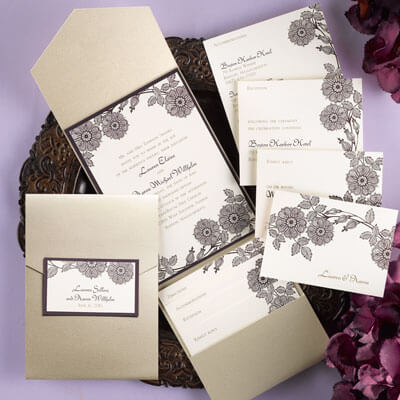Planning a wedding is a complicated business. From deciding on a color scheme and choosing your floral arrangements to finalizing your guest list and sending wedding invitations, there are a lot of details to consider.
Your stationery is one of the most important aspects of your wedding; it’s your primary method of communicating with your guests, and your stationery design and paper choice can set the tone for your entire event. But don’t panic – wedding stationery is also one of the easiest things to get sorted, especially with our guide.
What To Include in your Wedding Stationery Suite
Every wedding is different. Your wedding stationery suite can contain as many or as few items as you deem necessary – simpler affairs may only require a save the date, formal invitation, and a thank you card, but if your wedding is a little more complex, you may need a more robust suite.
For a comprehensive list of every printed item you’ll need for your wedding (and we mean every printed item), check out this downloadable checklist by UPrinting.com.
Let’s take a closer look at some of the most common components of any wedding stationery suite:
Save the Dates

Save the dates are sent well in advance of your wedding date to give your guests ample time to plan and make the necessary arrangements. They should be sent anywhere from 6-8 months before your wedding date.
Your save the dates should include:
- The names of the bride and groom
- The date of your wedding
- Location and venue information
- A link to your wedding website, if you have one
- A note that a formal invitation will follow – you’d be surprised how many people think that the save the date is their actual invitation!
Save the dates aren’t technically included in your formal invitation suite, so they’re the perfect opportunity to get creative! Try including a fun photo or play around with different fonts and colors. You can also coordinate your save the dates with your formal invitations to create a truly cohesive stationery suite.
Formal Invitations

Your formal invitations are the cornerstone of your stationery suite. They should be sent 4-8 weeks prior to your wedding, but this timeline is more flexible if you sent a save the date.
You should include the following information on your formal invitation:
- Host names: Mention the names of the event hosts first.
- The couple’s names: The bride’s name is typically noted before the groom’s.
- Event details: List important details like the date, time, and address for your venue.
- Post-ceremony details: Indicate whether there is a cocktail hour, dinner, or dancing to follow.
Your wedding invitation should not include any mention of your registry – this is usually communicated via word of mouth, on your wedding website, or on your bridal shower invitations.
DIYing your wedding invites? Take a look at our favorite invitation printables.
Reception Card
Formal wedding invitations are comprised of a number of components, including the invitation itself and a number of optional enclosures, such as a reception card, response card, accommodation card, and possibly more depending on the style and tone of your event.
If you’re holding your reception at a different venue than your ceremony or if you just don’t have space on your invite for reception information, you should enclose a separate reception card with your formal invitation.
Reception cards should include:

- The address of your reception, including directions and a map.
- A note on the formality of the event. If you want to be more specific about your event’s dress code, you may wish to enclose a separate card to suggest appropriate attire.
Response Card
Response cards give your guests a formal way to respond to your invitation. Most wedding invitation suites include matching response cards to enclose inside your inner envelope (more on these later).
Your response cards should include:
- A place for guests to write their names (but don’t be shocked if your guests accidentally leave this section blank).
- A self-addressed, stamped return envelope.
- Meal options or a space to note any dietary requirements.
If you’re using an online response service, you should still prepare and send paper response cards to guests who may not be comfortable responding online.
PRO TIP: A lot of people forget to write their names on their response cards. Avoid confusion by numbering your invitations on your guest list, then lightly printing each number on your guests’ corresponding response card. This way, you can easily keep track of who’s responded and who hasn’t.
Accommodation Card
Accommodation cards are essential for destination weddings, but they can also be very helpful for out of town guests if you’re having your wedding at home. Include relevant travel information such as nearby airports or rental car agencies, as well as a date to book by. If you’re covering the cost of the accommodation, you should mention that as well.
Inner Envelope

Your wedding stationery suite will contain two envelopes: an inner envelope and an outer envelope. The inner envelope contains your formal invitation as well as any enclosures, and is tucked inside and sent to your guests in your outer envelope.
Clearly write the names of each invited guest on the outside of the inner envelope so your recipients know exactly who is and isn’t invited to your wedding. If you’re inviting children, list the names and titles of parents first, then the names of the children. You can use familiar names if you prefer.
Outer Envelope
Your outer envelope protects your formal invitations from damage in the mailing process.
PRO TIP: Order extra outer envelopes in case you make a mistake addressing your invites.
Thank You Cards
While thank you cards aren’t officially part of your formal invitation suite, they are an essential piece of wedding stationery. It’s very important that you thank each guest for their presence at your wedding, even if they didn’t get you a gift.
Thank you cards should be sent no later than three months after your honeymoon for any gifts received on or after your wedding day. For gifts received before your wedding day, try to send a thank you card within two weeks of its arrival.
Here are some tips for writing and sending your thank you cards:
- Use your guest list to keep track of your thank you cards the same way you used your list to track your invites and response cards.
- Add a personal touch – thank you cards should always be hand written.
- Sign both of your names, regardless of who actually writes the note.
Shop our full selection of wedding stationery.
Invites, Away!
Wedding invitations are easy to DIY, even with all those enclosures, envelopes, and complicated rules of etiquette. Pre-cut and folded invitation ensembles make creating and sending your own invitation suite easy and economical, so there’s no need to stress over your save the dates, formal invitations, or thank you cards.
Take a look at our Wedding Inspiration category for more wedding stationery tips and suggestions.








